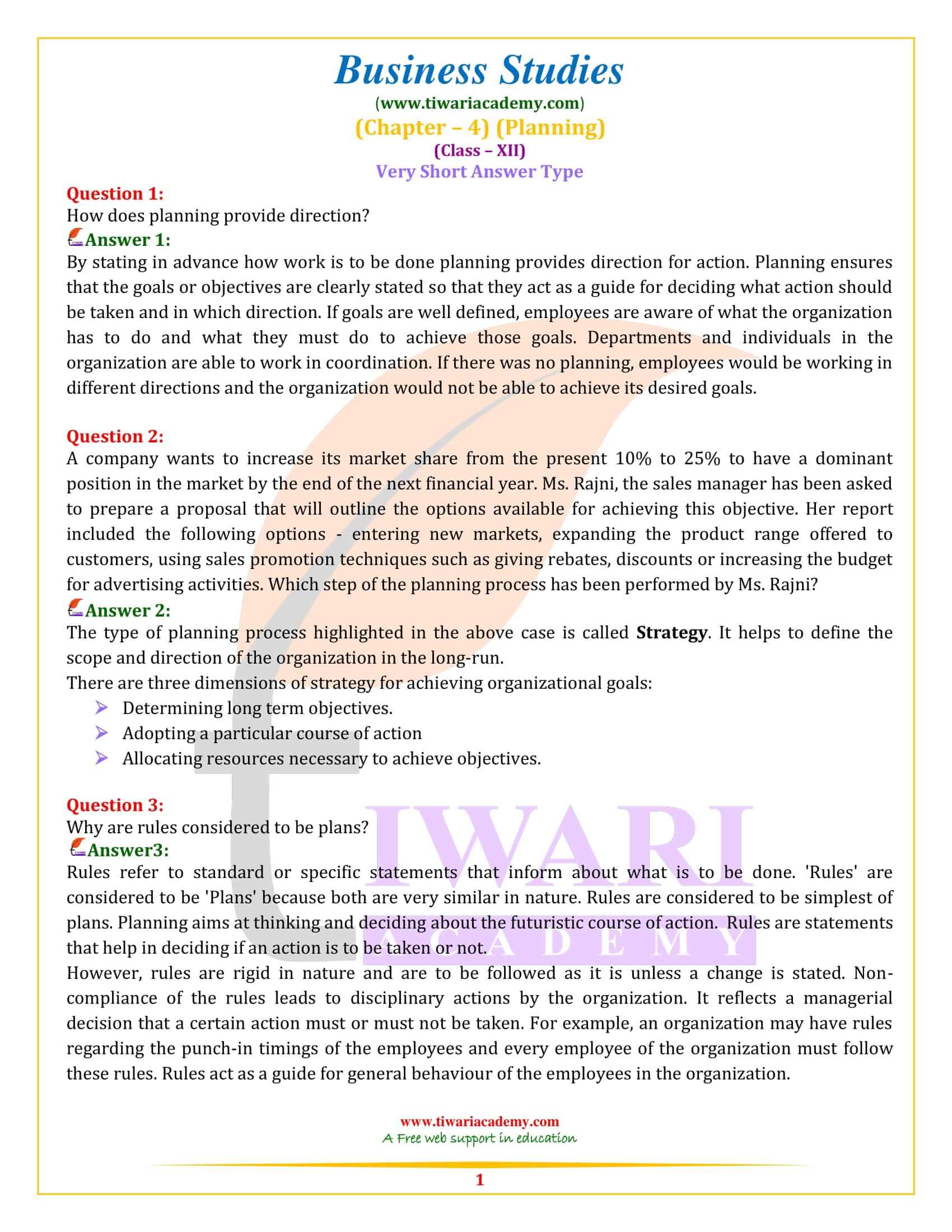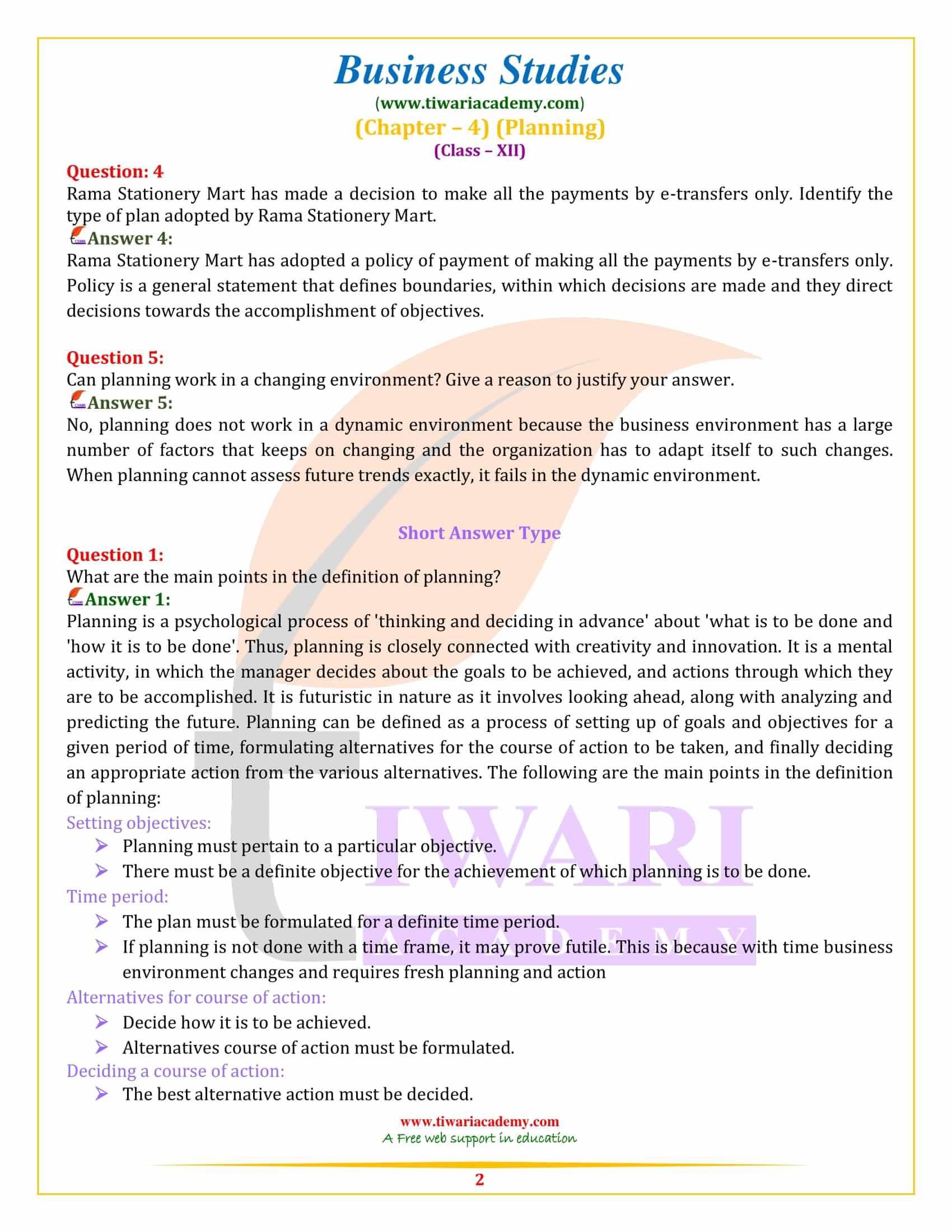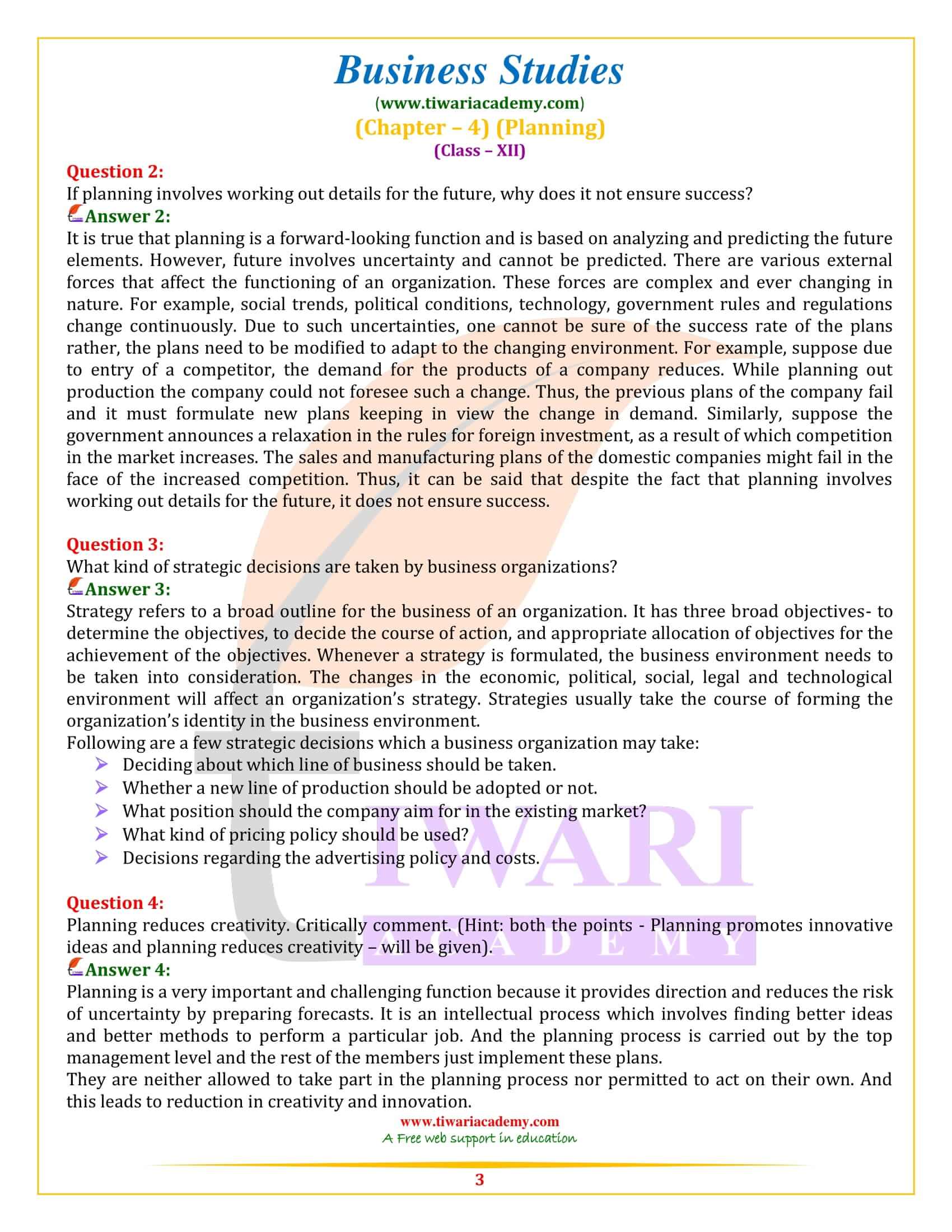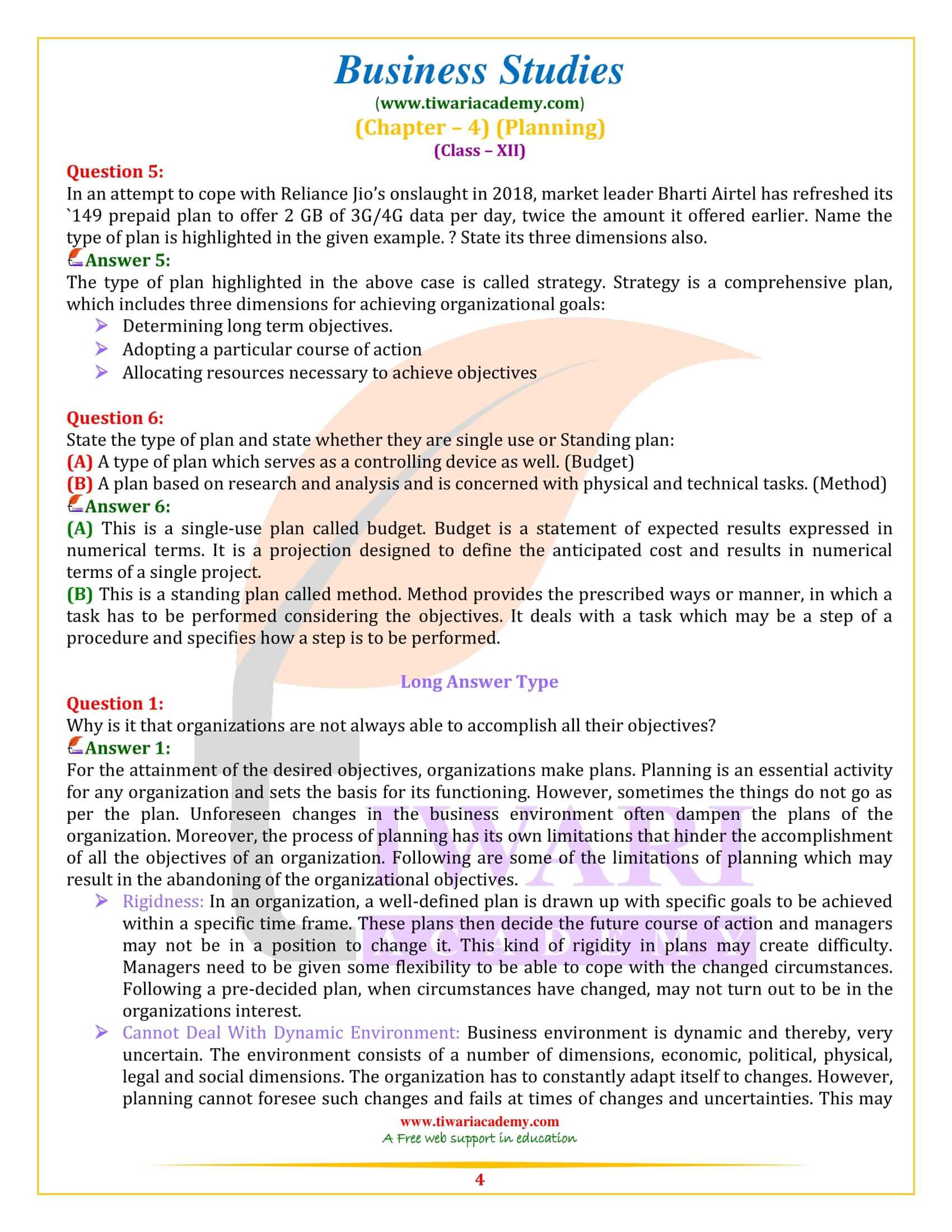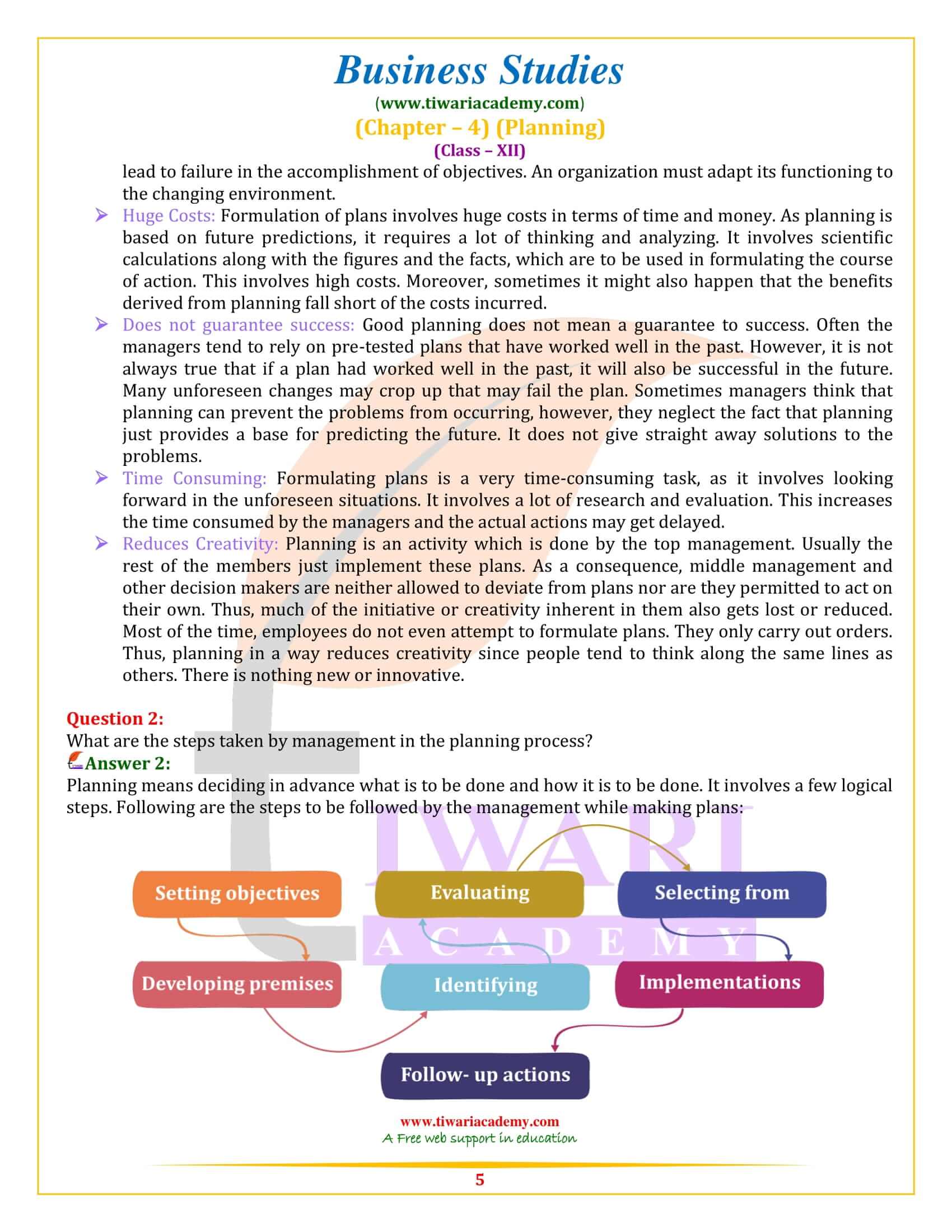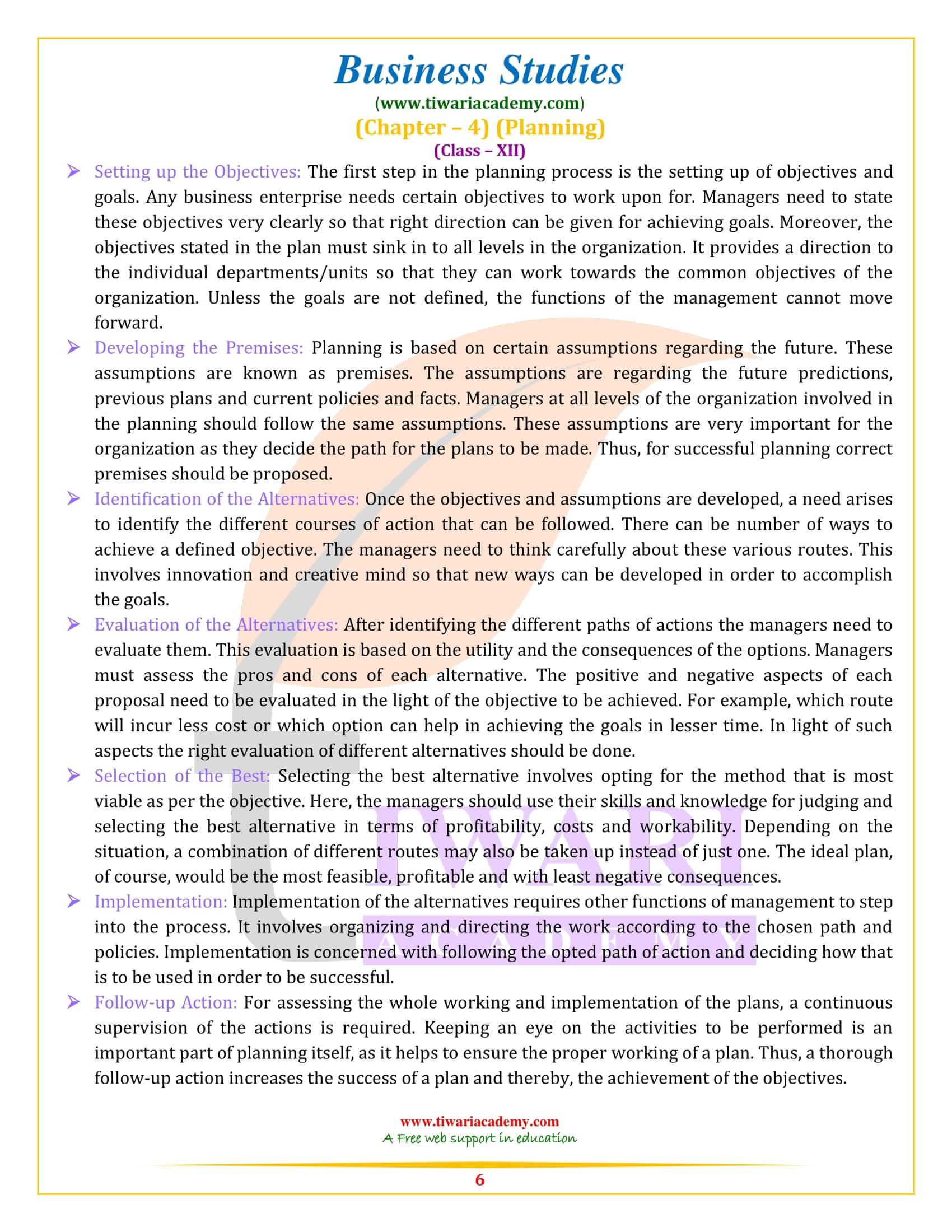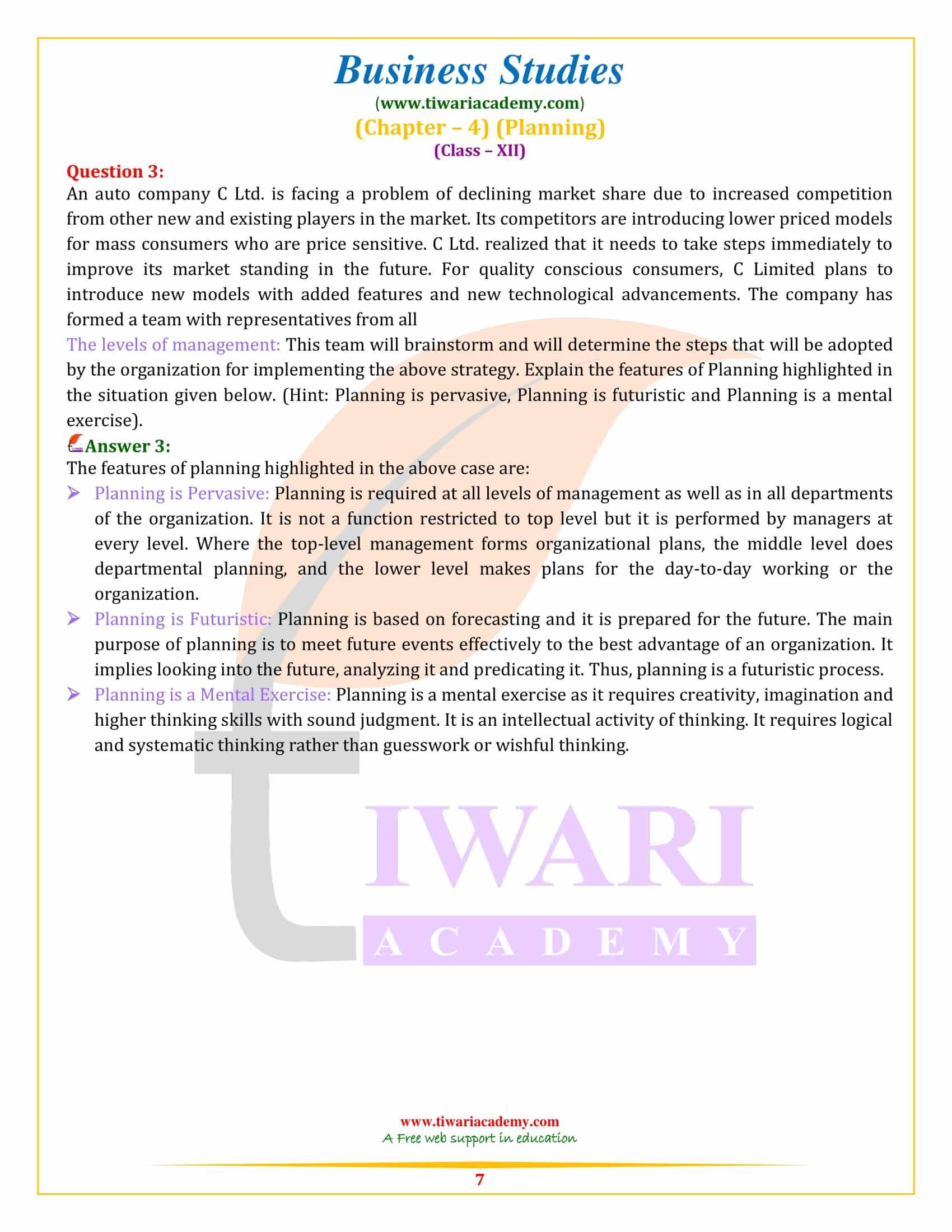NCERT Solutions for Class 12 Business Studies Chapter 4 Planning updated for new academic session 2024-25 following the new CBSE Syllabus. Answers of Chapter 4 Class 12 B St are explain well with suitable examples. It is easy to understand for all the students.
NCERT Solutions for Class 12 Business Studies Chapter 4
Class 12 Business Studies Chapter 4 NCERT Solutions
Very Short Answer Type
How does planning provide direction?
By stating in advance how work is to be done planning provides direction for action. Planning ensures that the goals or objectives are clearly stated so that they act as a guide for deciding what action should be taken and in which direction. If goals are well defined, employees are aware of what the organization has to do and what they must do to achieve those goals. Departments and individuals in the organization are able to work in coordination. If there was no planning, employees would be working in different directions and the organization would not be able to achieve its desired goals.
A company wants to increase its market share from the present 10% to 25% to have a dominant position in the market by the end of the next financial year. Ms. Rajni, the sales manager has been asked to prepare a proposal that will outline the options available for achieving this objective. Her report included the following options – entering new markets, expanding the product range offered to customers, using sales promotion techniques such as giving rebates, discounts or increasing the budget for advertising activities. Which step of the planning process has been performed by Ms. Rajni?
The type of planning process highlighted in the above case is called Strategy. It helps to define the scope and direction of the organization in the long-run.
There are three dimensions of strategy for achieving organizational goals:
- Determining long term objectives.
- Adopting a particular course of action
- Allocating resources necessary to achieve objectives.
Why are rules considered to be plans?
Rules refer to standard or specific statements that inform about what is to be done. ‘Rules’ are considered to be ‘Plans’ because both are very similar in nature. Rules are considered to be simplest of plans. Planning aims at thinking and deciding about the futuristic course of action. Rules are statements that help in deciding if an action is to be taken or not.
However, rules are rigid in nature and are to be followed as it is unless a change is stated. Non-compliance of the rules leads to disciplinary actions by the organization. It reflects a managerial decision that a certain action must or must not be taken. For example, an organization may have rules regarding the punch-in timings of the employees and every employee of the organization must follow these rules. Rules act as a guide for general behaviour of the employees in the organization.
Rama Stationery Mart has made a decision to make all the payments by e-transfers only. Identify the type of plan adopted by Rama Stationery Mart.
Rama Stationery Mart has adopted a policy of payment of making all the payments by e-transfers only. Policy is a general statement that defines boundaries, within which decisions are made and they direct decisions towards the accomplishment of objectives.
Can planning work in a changing environment? Give a reason to justify your answer.
No, planning does not work in a dynamic environment because the business environment has a large number of factors that keeps on changing and the organization has to adapt itself to such changes. When planning cannot assess future trends exactly, it fails in the dynamic environment.
Short Answer Type Question
What are the main points in the definition of planning?
Planning is a psychological process of ‘thinking and deciding in advance’ about ‘what is to be done and ‘how it is to be done’. Thus, planning is closely connected with creativity and innovation. It is a mental activity, in which the manager decides about the goals to be achieved, and actions through which they are to be accomplished. It is futuristic in nature as it involves looking ahead, along with analyzing and predicting the future. Planning can be defined as a process of setting up of goals and objectives for a given period of time, formulating alternatives for the course of action to be taken, and finally deciding an appropriate action from the various alternatives. The following are the main points in the definition of planning:
Setting objectives:
1. Planning must pertain to a particular objective.
2. There must be a definite objective for the achievement of which planning is to be done.
Time period:
1. The plan must be formulated for a definite time period.
2. If planning is not done with a time frame, it may prove futile. This is because with time business environment changes and requires fresh planning and action. Alternatives for course of action:
1. Decide how it is to be achieved.
2. Alternatives course of action must be formulated.
Deciding a course of action: The best alternative action must be decided.
If planning involves working out details for the future, why does it not ensure success?
It is true that planning is a forward-looking function and is based on analyzing and predicting the future elements. However, future involves uncertainty and cannot be predicted. There are various external forces that affect the functioning of an organization. These forces are complex and ever changing in nature. For example, social trends, political conditions, technology, government rules and regulations change continuously. Due to such uncertainties, one cannot be sure of the success rate of the plans rather, the plans need to be modified to adapt to the changing environment. For example, suppose due to entry of a competitor, the demand for the products of a company reduces. While planning out production the company could not foresee such a change. Thus, the previous plans of the company fail and it must formulate new plans keeping in view the change in demand. Similarly, suppose the government announces a relaxation in the rules for foreign investment, as a result of which competition in the market increases. The sales and manufacturing plans of the domestic companies might fail in the face of the increased competition. Thus, it can be said that despite the fact that planning involves working out details for the future, it does not ensure success.
What kind of strategic decisions are taken by business organizations?
Strategy refers to a broad outline for the business of an organization. It has three broad objectives- to determine the objectives, to decide the course of action, and appropriate allocation of objectives for the achievement of the objectives. Whenever a strategy is formulated, the business environment needs to be taken into consideration. The changes in the economic, political, social, legal and technological environment will affect an organization’s strategy. Strategies usually take the course of forming the organization’s identity in the business environment. Following are a few strategic decisions which a business organization may take:
- Deciding about which line of business should be taken.
- Whether a new line of production should be adopted or not.
- What position should the company aim for in the existing market?
- What kind of pricing policy should be used?
- Decisions regarding the advertising policy and costs.
Planning reduces creativity. Critically comment. (Hint: both the points – Planning promotes innovative ideas and planning reduces creativity – will be given).
Planning is a very important and challenging function because it provides direction and reduces the risk of uncertainty by preparing forecasts. It is an intellectual process which involves finding better ideas and better methods to perform a particular job. And the planning process is carried out by the top management level and the rest of the members just implement these plans.
They are neither allowed to take part in the planning process nor permitted to act on their own. And this leads to reduction in creativity and innovation.
In an attempt to cope with Reliance Jio’s onslaught in 2018, market leader Bharti Airtel has refreshed its Rs. 149 prepaid plan to offer 2 GB of 3G/4G data per day, twice the amount it offered earlier. Name the type of plan is highlighted in the given example. ? State its three dimensions also.
The type of plan highlighted in the above case is called strategy. Strategy is a comprehensive plan, which includes three dimensions for achieving organizational goals:
- Determining long term objectives.
- Adopting a particular course of action.
- Allocating resources necessary to achieve objectives.
State the type of plan and state whether they are single use or Standing plan:
(A) A type of plan which serves as a controlling device as well. (Budget)
(B) A plan based on research and analysis and is concerned with physical and technical tasks. (Method)
(A) This is a single-use plan called budget. Budget is a statement of expected results expressed in numerical terms. It is a projection designed to define the anticipated cost and results in numerical terms of a single project.
(B) This is a standing plan called method. Method provides the prescribed ways or manner, in which a task has to be performed considering the objectives. It deals with a task which may be a step of a procedure and specifies how a step is to be performed.
Long Answer Type
Why is it that organizations are not always able to accomplish all their objectives?
For the attainment of the desired objectives, organizations make plans. Planning is an essential activity for any organization and sets the basis for its functioning. However, sometimes the things do not go as per the plan. Unforeseen changes in the business environment often dampen the plans of the organization. Moreover, the process of planning has its own limitations that hinder the accomplishment of all the objectives of an organization. Following are some of the limitations of planning which may result in the abandoning of the organizational objectives.
1. Rigidness: In an organization, a well-defined plan is drawn up with specific goals to be achieved within a specific time frame. These plans then decide the future course of action and managers may not be in a position to change it. This kind of rigidity in plans may create difficulty. Managers need to be given some flexibility to be able to cope with the changed circumstances. Following a pre-decided plan, when circumstances have changed, may not turn out to be in the organizations interest.
2. Cannot Deal With Dynamic Environment: Business environment is dynamic and thereby, very uncertain. The environment consists of a number of dimensions, economic, political, physical, legal and social dimensions. The organization has to constantly adapt itself to changes. However, planning cannot foresee such changes and fails at times of changes and uncertainties. This may lead to failure in the accomplishment of objectives. An organization must adapt its functioning to the changing environment.
3. Huge Costs: Formulation of plans involves huge costs in terms of time and money. As planning is based on future predictions, it requires a lot of thinking and analyzing. It involves scientific calculations along with the figures and the facts, which are to be used in formulating the course of action. This involves high costs. Moreover, sometimes it might also happen that the benefits derived from planning fall short of the costs incurred.
4. Does not guarantee success: Good planning does not mean a guarantee to success. Often the managers tend to rely on pre-tested plans that have worked well in the past. However, it is not always true that if a plan had worked well in the past, it will also be successful in the future. Many unforeseen changes may crop up that may fail the plan. Sometimes managers think that planning can prevent the problems from occurring, however, they neglect the fact that planning just provides a base for predicting the future. It does not give straight away solutions to the problems.
5. Time Consuming: Formulating plans is a very time-consuming task, as it involves looking forward in the unforeseen situations. It involves a lot of research and evaluation. This increases the time consumed by the managers and the actual actions may get delayed.
6. Reduces Creativity: Planning is an activity which is done by the top management. Usually the rest of the members just implement these plans. As a consequence, middle management and other decision makers are neither allowed to deviate from plans nor are they permitted to act on their own. Thus, much of the initiative or creativity inherent in them also gets lost or reduced. Most of the time, employees do not even attempt to formulate plans. They only carry out orders. Thus, planning in a way reduces creativity since people tend to think along the same lines as others. There is nothing new or innovative.
What are the steps taken by management in the planning process?
Planning means deciding in advance what is to be done and how it is to be done. It involves a few logical steps. Following are the steps to be followed by the management while making plans:
1. Setting up the Objectives: The first step in the planning process is the setting up of objectives and goals. Any business enterprise needs certain objectives to work upon for. Managers need to state these objectives very clearly so that right direction can be given for achieving goals. Moreover, the objectives stated in the plan must sink in to all levels in the organization. It provides a direction to the individual departments/units so that they can work towards the common objectives of the organization. Unless the goals are not defined, the functions of the management cannot move forward.
2. Developing the Premises: Planning is based on certain assumptions regarding the future. These assumptions are known as premises. The assumptions are regarding the future predictions, previous plans and current policies and facts. Managers at all levels of the organization involved in the planning should follow the same assumptions. These assumptions are very important for the organization as they decide the path for the plans to be made. Thus, for successful planning correct premises should be proposed.
3. Identification of the Alternatives: Once the objectives and assumptions are developed, a need arises to identify the different courses of action that can be followed. There can be number of ways to achieve a defined objective. The managers need to think carefully about these various routes. This involves innovation and creative mind so that new ways can be developed in order to accomplish the goals.
4. Evaluation of the Alternatives: After identifying the different paths of actions the managers need to evaluate them. This evaluation is based on the utility and the consequences of the options. Managers must assess the pros and cons of each alternative. The positive and negative aspects of each proposal need to be evaluated in the light of the objective to be achieved. For example, which route will incur less cost or which option can help in achieving the goals in lesser time. In light of such aspects the right evaluation of different alternatives should be done.
5. Selection of the Best: Selecting the best alternative involves opting for the method that is most viable as per the objective. Here, the managers should use their skills and knowledge for judging and selecting the best alternative in terms of profitability, costs and workability. Depending on the situation, a combination of different routes may also be taken up instead of just one. The ideal plan, of course, would be the most feasible, profitable and with least negative consequences.
6. Implementation: Implementation of the alternatives requires other functions of management to step into the process. It involves organizing and directing the work according to the chosen path and policies. Implementation is concerned with following the opted path of action and deciding how that is to be used in order to be successful.
7. Follow-up Action: For assessing the whole working and implementation of the plans, a continuous supervision of the actions is required. Keeping an eye on the activities to be performed is an important part of planning itself, as it helps to ensure the proper working of a plan. Thus, a thorough follow-up action increases the success of a plan and thereby, the achievement of the objectives.
FAQs
What is the significance of chapter 4 the planning topic?
Planning is the first in the series managerial functions. It precedes all of other functions.
Which topic in business studies closely connected to chapter 4?
Controlling. In fact, it is recommended that planning and controlling topics should be studied one after the other.
The term planning has a specific meaning here. It is basically setting up of standards particularly in quantitative terms to remove uncertainty among the subordinates to achieve organizational goals.
What is the important or difficult topic in chapter 4 of Class 12 Business Studies?
The types of plans namely standing plans and one time plans is the most important topic in this chapter. It should be revised thoroughly because it can be asked in case studies also.
